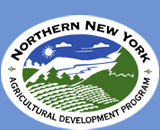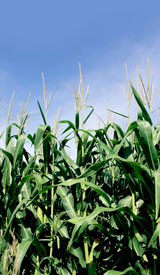April 6, 2010
Contacts: see list at end
Thankful for Manure: Nutrient Management Info Now Online at
www.nnyagdev.org
Efficient use of manure and other nutrient sources, including soil, crop
residue and purchased fertilizer, can save farmers money. To help North
Country farmers reduce fertilizer costs without comprising crop quality
or yield, the Northern New York Agricultural Development Program has
posted a dozen articles and four farmer profiles written by NNY Cornell
Cooperative Extension field crops educators, W.H. Miner Agricultural
Research Institute Agronomist Eric Young and Cornell University staff at
http://www.nnyagdev.org/_agbasedevironmgmt.htm#Fertilizer_Management
Cornell Cooperative Extension Lewis County Field Crops Educator Joseph
R. Lawrence, author of several of the articles posted online, says,
“Volatility in the commercial fertilizer markets has led to escalating
prices and reduced availability issues that have farmers asking just how
many nutrients crops need and the best way to get those nutrients to the
crops.”
“Be Thankful for Your Manure” author W.H. Miner Agricultural Institute
Agronomist Eric Young, says, “In these tough economic times, it is good
to estimate the value of liquid dairy manure already on the farm and
that does not cost anything. Some people are surprised to learn that a
4,500-gallon load of liquid dairy manure is worth about two cents per
gallon ($90/load) considering just its N-P-K (nitrogen, phosphorus,
potassium) nutrient value.”
Young points out that dairy manure also provides such important
nutrients as sulfur, manganese, iron, copper, chloride, molybdenum,
zinc, boron and organic carbon.
“The bottom line is we should view manure as the true nutrient source
that it is. Our five-million gallon manure pit at Miner Institute
represents approximately $100,000 worth of N-P-K value that does not
have to be purchased,” Young says.
Lawrence, Young, and Cornell Cooperative Extension Jefferson County
Field Crops Educator Michael E. Hunter recommend using the latest tests
and tools to determine nutrient availability and nutrient needs.
“By utilizing soil and manure test analysis with farm crop plans,
farmers can avoid spending money on unneeded fertilizer,” Lawrence says.
“The tests help identify the nutrients you can obtain from on-farm
fertilizer sources, which, in turn, promotes good environmental
stewardship.”
Young adds, “Recent research by Cornell University has demonstrated
promise for using the Illinois Soil Nitrogen Test (ISNT) in New York
corn fields. A recently-published study showed that the ISNT corrected
for organic matter content was 83 percent accurate in predicting the
nitrogen responsiveness of second-year corn fields.”
In “Manure Nutrient Credit Calculators Online,” Hunter suggests using
three software-based tools developed by Cornell University’s Nutrient
Management Spear Program.
“These computerized programs calculate the available nutrients from
manure and plowed sods and the nitrogen requirements to grow corn in New
York,” Hunter says. “They provide the user with valuable information
needed to make accurate and prudent fertilizer-use decisions on an
individual field basis.”
NNY farmers are using the results of crop nutrient management research
funded by the farmer-driven Northern New York Agricultural Development
Program (NNYADP) and conducted by Cornell researchers on NNY farms and
at Miner Institute to harvest cost savings.
Cornell Nutrient Management Spear Program Director Dr. Quirine M.
Ketterings says, “Based on research conducted in Northern New York and
combined with similar work elsewhere in New York state, we conclude that
first-year corn does not require any additional N beyond
small starter nitrogen application of about 30 lbs. per acre.”
“Given the high price of nitrogen and the continued price uncertainty,
using nitrogen tests to fine-turn corn N needs makes economic sense,”
Young says.
The nutrient management resources online at www.nnyagdev.org and
available from Cornell Cooperative Extension offices and the W.H. Miner
Agricultural Research Institute include:
• Do Your Fields Need Lime? – J. Lawrence, CCE Lewis County
• Estimating the fertilizer value of manure – E. Young, WH Miner
Institute
• Fertilizer: So Many Choices – Part 1 – J. Lawrence, CCE Lewis County
• Fertilizer: So Many Choices – Part 2 – J. Lawrence, CCE Lewis County
• Fertilizer: So Many Choices – Part 3 – J. Lawrence, CCE Lewis County
• Liming Materials: Know what you are getting – J. Lawrence, CCE Lewis
County
• Manure Nutrient Credit Calculators Online – M. Hunter, CCE Jefferson
County
• Nitrogen Fertilizer 101 – M. Hunter, CCE Jefferson County
• A Second Look at Nitrogen Additives – J. Lawrence, CCE Lewis County
• Soil Nitrogen Testing for Corn – E. Young, WH Miner Institute
• Soil Testing for Corn Nitrogen Needs – E. Young, WH Miner Institute
• Hotlink to Whole farm nutrient balancing resources at Cornell
University.
The series also includes profiles on Northern New York farmers:
• Research leads to lower nitrogen rates on corn at Kiechle farm
• Lewis County Farmer Darren McIntyre Participates in Statewide Manure
Incorporation Project
• St. Lawrence County Farmer Dan Chambers Sees Promising Results from
Manure Incorporation Trials
• Timing is Right for Manure Incorporation Study at Mapleview Dairy LLC
in St Lawrence County.
For more information, contact:
• Clinton County Cornell Cooperative Extension: Peter Hagar,
518-561-7450
• Clinton County: W.H. Miner Agricultural Research Institute, Eric
Young, 518-846-7121
• Essex County Cornell Cooperative Extension: Anita Deming, 518-962-4810
• Cornell University E.V. Baker Research Farm at Willsboro, Michael
Davis, 518-963-7492
• Franklin County Cornell Cooperative Extension: Stephen Canner,
518-483-7403
• Jefferson County Cornell Cooperative Extension: Mike Hunter,
315-788-8450
• Lewis County Cornell Cooperative Extension: Joe Lawrence, 315-376-5270
• St. Lawrence County Cornell Cooperative Extension: Stephen Canner,
315-379-9192.
# # #



